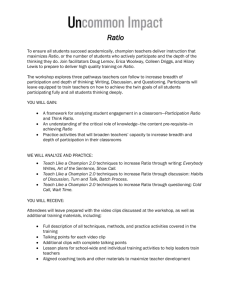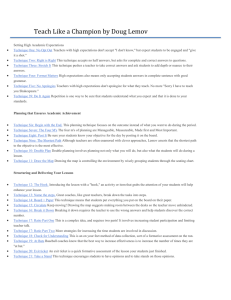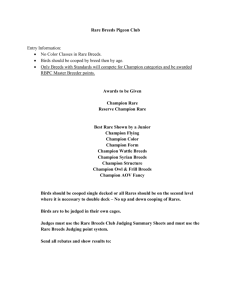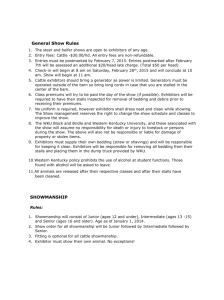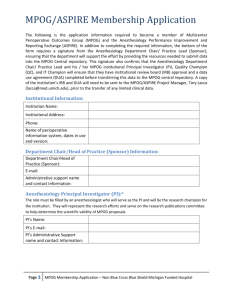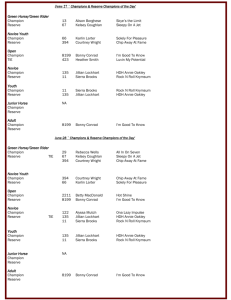Champion`s Teach Like a Champion
advertisement
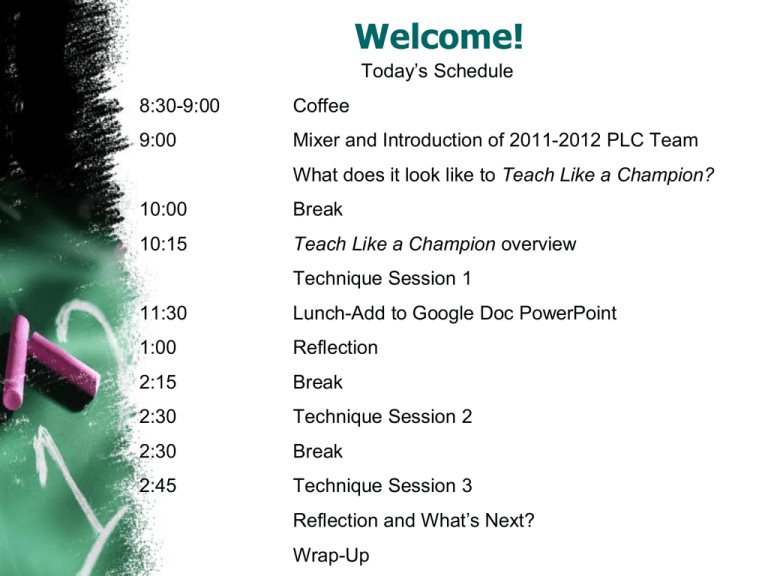
Welcome! Today’s Schedule 8:30-9:00 Coffee 9:00 Mixer and Introduction of 2011-2012 PLC Team What does it look like to Teach Like a Champion? 10:00 Break 10:15 Teach Like a Champion overview Technique Session 1 11:30 Lunch-Add to Google Doc PowerPoint 1:00 Reflection 2:15 Break 2:30 Technique Session 2 2:30 Break 2:45 Technique Session 3 Reflection and What’s Next? Wrap-Up Teach Like A Champion: 49 Techniques that Put Students on the Path to College By Doug Lemov Boerne-Samuel V. Champion High School PLC August 15, 2011 Michele Mills Eddie Salas Michele Harris Steve Pena Jayne Burton What Does Teaching Like a Champion Look Like? • This is a multi-modal opportunity to display your knowledge. • Choose from the following techniques for your group presentation: Sculpt-It Paint-It Sing-It Dance-It Tech-It Collage-It Write-It Act-It Draw-It Activity Parameters • You have 15 minutes to show through your chosen medium what great teaching is. • There are limited resources on the table. • Each group will have 2 minutes to make their presentations. Share-Out What does it look like to TEACH LIKE A CHAMPION? That was AWESOME! Time for a Break Book Introduction http://www.youtube.com/watch?v=r1CMvuFLfxc About the Author, Doug Lemov • Taught English and history at university, high school, middle school levels • MBA from Harvard Business School • Founder/Principal of the Academy of the Pacific Rim Charter School in Boston • Managing Director, Uncommon Schools 16 college prep charter high need schools in NY/NJ • President of School Performance Organization helping schools use data for decision making • Vice President for Accountability at the State University of New York Charter Schools Institute Teaching Like A Champion • Building systems of classroom culture and instruction • Taxonomy of effective teaching practices • Micro-techniques that make all the difference in student learning • Techniques vs. strategy: A thing you say or do in a particular way vs. a generalized approach • Transforming students at risk of failure into achievers and believers The Essential Techniques Setting High Academic Expectations Planning that Ensures Academic Achievement Structuring and Delivering Your Lessons Engaging Students in Your Lessons Creating a Strong Classroom Culture Setting and Maintaining High Behavioral Expectations Building Character and Trust Improving Your Pacing : Additional Techniques for Creating a Positive Rhythm in the Classroom Challenging Students to Think Critically The Five Principles of Classroom Culture 1. Discipline 2. Management 3. Control 4. Influence 5. Engagement The Synergy of the Five Principles Teaching Techniques • Tight Transitions (154) • Entry Routines (151) • Props (163) • Do Now (152) Share-out/Reflection • Think-Group-Share Think of how you would use these techniques in your class. Share with your small group. During lunch: • Log onto BISD Google Apps • Edit the PowerPoint, “Creating a Champion Classroom Culture,” by adding your group notes to a group slide. Lunch • Do not forget to create your group slide by editing our Google Doc! Taking a Look Back Reflecting on your teaching experiences from last school year: • What do you need to STOP doing? • What do you need to CHANGE? • What is working so well that you want to SHARE it with the world? Share-Out • Voice Matters! • What do you need to STOP doing? • What do you need to CHANGE? • What is working so well that you want to SHARE it with the world? Setting High Academic Expectations • Living up to our school name. • “Everybody learns in a highperforming classroom, and expectations are high even for students who don’t yet have high expectations for themselves” (28). No Opt Out (28) • High expectations for all students • “It’s not okay not to try.” • Sequence of helping reluctant students answer questions and participate successfully • A technique that normalizes the process with students who need it the most. • Four different formats Clip 1 http://www.youtube.com/watch?v=UwnGusgqDEc No Opt Out (28) • Possible reasons that students might opt out of answering a question you have asked: A student is actively testing or defying you. A student is trying not to stand out in the classroom. A student genuinely does not know the answer. A student is embarrassed to not know the answer. A student did not hear you when you asked. A student did not understand what you asked. Right is Right (35) • High standard for correctness: 100% • Hold out for all the way correctness • Use positive language Students: • Right answer, right time • Use technical vocabulary Clip 3 Format Matters (47) • Grammatical Format • Complete Sentences • Sentence starters • Reminders • Audible Format • “Voice” • Unit Format (math and science) Example of Right is Right and Format Matters Renatta Gass is out with friends when they find themselves getting a workout. They must apply a cumulative force of 1080 N to push the car 218 m to the nearest gas station. How much work was done on the car? Share-Out/Reflection • Think-Group-Share Think of how you would use these techniques in your class. Share with your small group. Share with the large group. Break • Scavenger Hunt Images Engaging Your Students Engaging Your Students • Carry-over from Eric Jensen’s Brain-Based Learning • Engaging students makes them feel as if they are active participants in the lesson. • Focused involvement in the classroom. • Students should not only be engaged in the class, but in the work of the class. • Be careful of substituting “frills” for SUBSTANCE! Cold Call (111) • Predictable – anticipation keeps students engaged • Systematic – universal not personal • Positive – fosters positive engagement • Scaffolded – simple to harder questions Clips 7-8 Cold Call Technology • Teacher’s Pick iPhone App Thanks to Rhonda Booth for the tip! • When you come across something great! Share it on the Champion PLC Wiki: http://championpd.wikispaces.com/ Stretch It (41) • Rewarding right answers with more questions • Used to check for understanding • Challenge students to apply their knowledge. • Ask how or why • Ask for another way to answer • Ask for a better word • Ask for evidence • Ask students to integrate a related skill • Students apply skills in new setting Clip 4 Everybody Writes (137) • Model…Model…Model!!!!!! Show the type of writing that is required by your discipline. Expect students to “format.” • Reflect in writing before discussing “I write to know what I think.”~Joan Didion • Every student participates • Thought refining process • Students remember twice as much Clip 12 Exit Tickets (106) • Make it quick • Data, Data, and more Data • Opportunity to analyze your lesson Every Minute Matters (230) • We know the expectation • WORK BELL TO BELL! • Time is precious and should not be given away blithely. “We don’t have time to start anything new.” “We worked hard, so I’m giving you all a few minutes to relax.” • Use the time for high-energy review. • Use the time to pose challenges. Share-Out/Reflection • On a Post-It note pick one technique and describe how you will use it in your classroom. • Slap your Exit Ticket on one of the posters by the lobby doors. • We will discuss the responses after the break. Break • Scavenger Hunt Images Follow-Up • Exit Tickets A Little Extra Tip: • Did you know that the Post-It Note folks have a great website for lessons using Post-It Notes? http://teachers.post-it.com/wps/portal/3M/en_US/Post-itTeachers/Home/ What’s Next? Champion Teachers using Champion Techniques • Read the book! We’ve given you the 3-D trailer! There are three dozen more techniques to explore (and a part 2). • Invitations/Requests to visit classes Colleagues visiting each others’ classrooms to get great teaching tips • Documenting through video Sharing through a “Flip-Out” • Great teaching techniques in action archived for posterity. Final Thoughts and Wrap-Up A good teacher is like a candle - it consumes itself to light the way for others. ~Author Unknown
